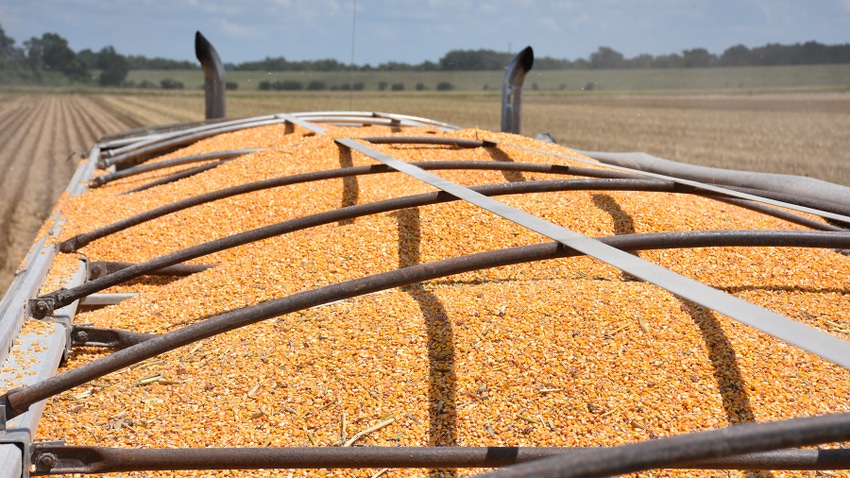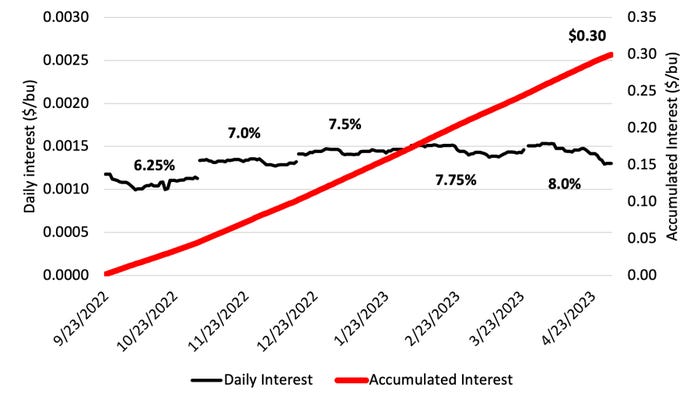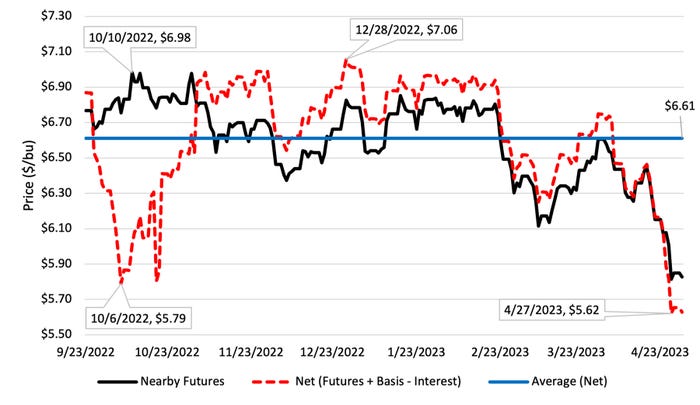
Interest rates have become an important consideration for row crop producers. From December 2008 until March 2022, interest rates were historically low with the bank prime rate between 3.25% and 5.5%.
Low interest rates allowed producers to borrow money at minor costs to cover the cost of production and capital expenditures. Additionally, low interest rates muted the costs of carrying crops in storage.
Over the past year, rising interest rates have required additional scrutiny for producers making management and marketing decisions.
From March 16, 2022, to May 1, 2023, the bank prime rate increased 4.75 points (3.25% to 8.0%). The rapid interest rate increase has impacted production costs, capital investment, and marketing for producers.
Impact of interest rates
This article examines the impact of interest rates and basis on net cash selling price for corn. Producers holding grain in storage should estimate interest costs as well as other storage costs.
Here we only show the impact of interest costs at the bank prime lending rate. For producers that do not have outstanding operating loans, they should consider the forgone investment interest rate. The rapid increase in interest rates makes this analysis even more critical as the Federal Reserve contemplates further interest rate increases.
The daily interest cost for corn in storage can be estimated as the nearby futures price plus basis multiplied by the interest rate divided by 365 days (Figure 1).
Movements in the nearby futures market, changes in basis, and changes in the interest rate will impact the daily interest cost.
Accumulated interest
Daily interest expenses can be summed from one date to another to estimate the accumulated interest cost over the period that grain is held in storage. For example, in Figure 1, the accumulated interest from September 23 to May 1 was $0.30/bu.
Accumulated interest cost is less at the start and increases the longer corn is held.
Figure 1. Bank Prime Rate and Daily and Accumulated Interest for Unsold Corn

*Daily interest = (futures + basis) x (bank prime rate / 365)
*Accumulated interest = sum of daily interest while held in storage.
Futures prices and basis prices change daily, affecting cash prices producers receive.
Using nearby corn futures prices, basis prices from USDA AMS for Northwest Tennessee, and daily accumulated interest costs, a net price was estimated from September 23, 2022, to May 1, 2023 (Figure 2).
Net price
The net price can be compared to the nearby futures price. In September and October, basis was weak due to the large quantity of available corn at harvest and transportation challenges, due to low water levels on the Mississippi River.
The accumulated interest cost was less than 5 cents per bushel through the end of October. The net price peaked on December 27 at $7.06 per bushel when accumulated interest was $0.12 per bushel, and the basis was 35 cents per bushel over the March futures contract.
Based on Figure 2, the best time to make sales at elevators and barge points in Northwest Tennessee occurred between November 3 and February 21. Since the end of February, declines in futures markets and increased accumulated interest costs have resulted in substantially lower net prices for producers.
Higher interest rates have necessitated a more stringent accounting of interest costs.
Producers should regularly evaluate these costs along with future expected prices when making marketing decisions to find the optimal time to sell stored grain.
Figure 2. Nearby Corn Futures Price and Net (Futures + Basis – Interest) Price

Source: Southern Ag Today
About the Author(s)
You May Also Like






